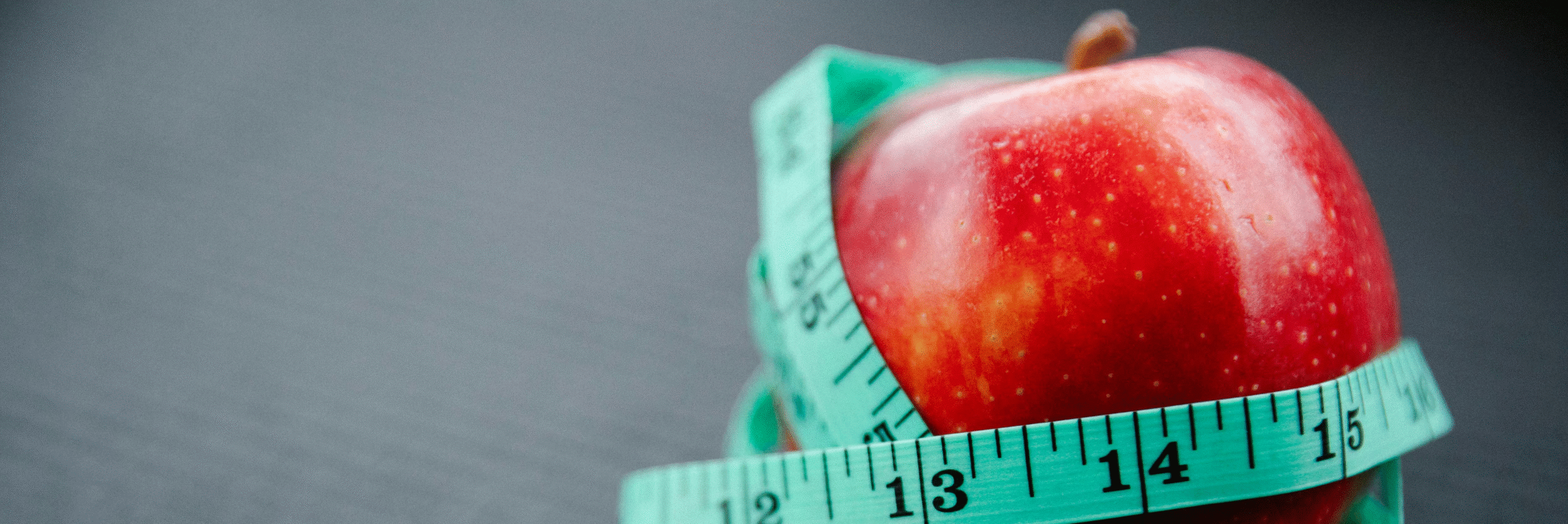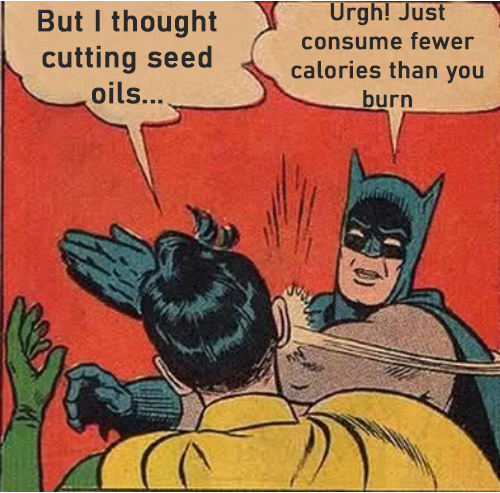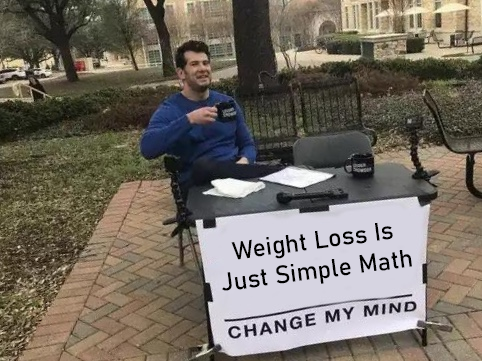
Low-carb, carnivore, juice cleanses, seed-oil panic—every trend promises magic. Yet every trend that works does it the exact same way: you burn more calories than you eat.
Weight-loss isn’t easy, but the formula is simple: consume fewer calories than you burn.
Calorie math decides what the bathroom scale says—period. Eat more than you burn and your weight drifts upward; eat less and it drifts down. Everything else—carb timing, detox teas, “hormone resets”—is background noise if the numbers don’t balance.
That doesn’t mean hormones and food quality don’t matter for health or hunger. They absolutely do. But when the goal is fat-loss, they’re secondary knobs you twist after the calorie dial is set. Ignore that dial and no fancy protocol can bail you out.
Even more basic: if you burn 2200 calories a day naturally (more on that later), then consuming fewer calories than 2200 will make you lose weight. Consume more than that: you’ll gain weight. IT’S THAT SIMPLE.
So today’s post is laser-focused on the one variable you control first: creating and calibrating a daily calorie deficit. You’ll learn the simplest math, the safest intake floors, and exactly how long a realistic deficit takes to move the scale.
Bottom line: master the calorie budget and the pounds follow—every proven diet works only because it nails this math. Let’s do the same for you.
Why a Calorie Deficit Is King 👑
-
First law of thermodynamics: energy can’t be created or destroyed—just stored or spent. (source)
-
Metabolic-ward studies confirm that whether subjects eat 80 % carbs or 80 % fat, body-weight change tracks the size of the calorie gap. (source)
-
Two-year CALORIE trial: people who slashed ~12 % of daily intake kept off ~10 % of body-weight with no special diet rules. (source)
Consume fewer calories than you burn, lose fat—no wand, just math.
Simple Math: How Fast Will You Lose?
Example:
Calories burned per day (maintenance) 2 000
Calories eaten per day 1 500
Deficit 500 kcal / day
1 pound fat ≈ 3 500 kcal → 3 500 ÷ 500 = 7 days to drop a pound.
That’s it—budget math in sweatpants.
 Three Steps to Set Your Daily Calories
Three Steps to Set Your Daily Calories
1. Know your maintenance (RMR).
Use the calculator below; it estimates your Resting Metabolic Rate with the Mifflin–St Jeor equation—one of the most accurate formulas we have.
2. Choose a sensible deficit.
-
Beginners: 15–20 % below maintenance.
-
Advanced cutters: 25 % max (hunger skyrockets beyond that).
3. Re-check every month.
When you’re down 5 lb (≈ 2 kg), rerun the calculator—smaller bodies burn fewer calories.
Safety First: Minimum Intake Floors
| Biological Sex | Absolute floor (do NOT go lower) |
|---|---|
| Male | 1 500 kcal |
| Female | 1 200 kcal |
Going lower risks nutrient deficiency and hormone havoc—talk to your doctor first.
Myth Buster Box
| Claim | Reality |
|---|---|
| “It’s all about insulin/carbs.” | Subjects in tightly controlled trials lost identical fat at the same calorie deficit, regardless of carb vs fat split. (source) |
| “Clean foods beat junk foods.” | Dr. Mark Haub’s Twinkie Diet: 1 800 kcal/day of snack cakes → 27 lb lost in 10 weeks—because calories were lower. (source) |
Ready? Run the Calculator
RMR & Daily Calories Calculator
Plug in your stats, hit Calculate, and write the number down—ink beats memory.
RMR & Calories Calculator
Estimate your daily calorie target
RMR (Resting Metabolic Rate): —
Recommended Calories / Day: —
*Based on the the Mifflin-St Jeor Equation—one of the most accurate formulas available.
FAQ
Q: Is a 500-calorie deficit always best?
A: It’s a solid middle ground. Larger bodies can handle 600–700; smaller bodies may need 300–400.
Q: Does food quality matter at all?
A: Yes—for health, energy, and fullness. But for fat-loss math, quantity > quality.
Q: How often should I adjust calories?
A: Any time weight changes by ~5 lb or progress stalls for three weeks.
Bottom Line
Calorie deficits aren’t sexy, but they’re undefeated. Figure out maintenance, shave off 15–20 %, eat real food most of the time, and let the math compound. Questions or confessionals? Drop them below—we answer every one (usually while sipping a chalky-but-worth-it protein shake).
As always, if you’re ready to lose weight and change your life for the better, check out our free beginner’s guide to weight loss.
